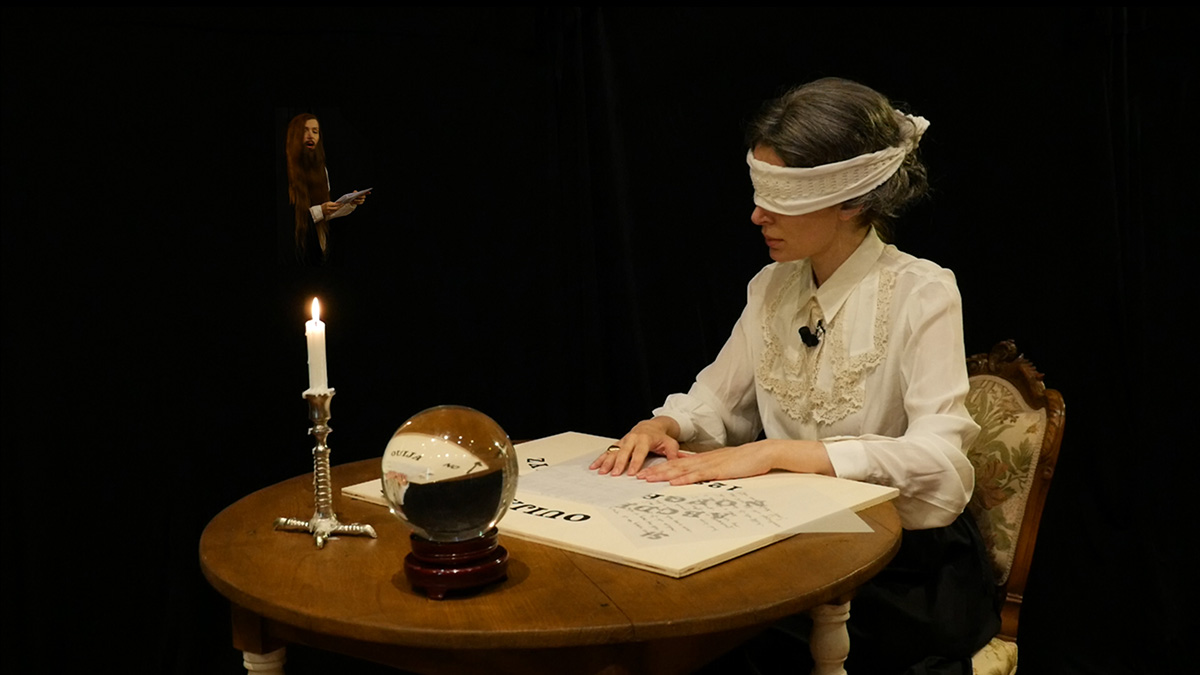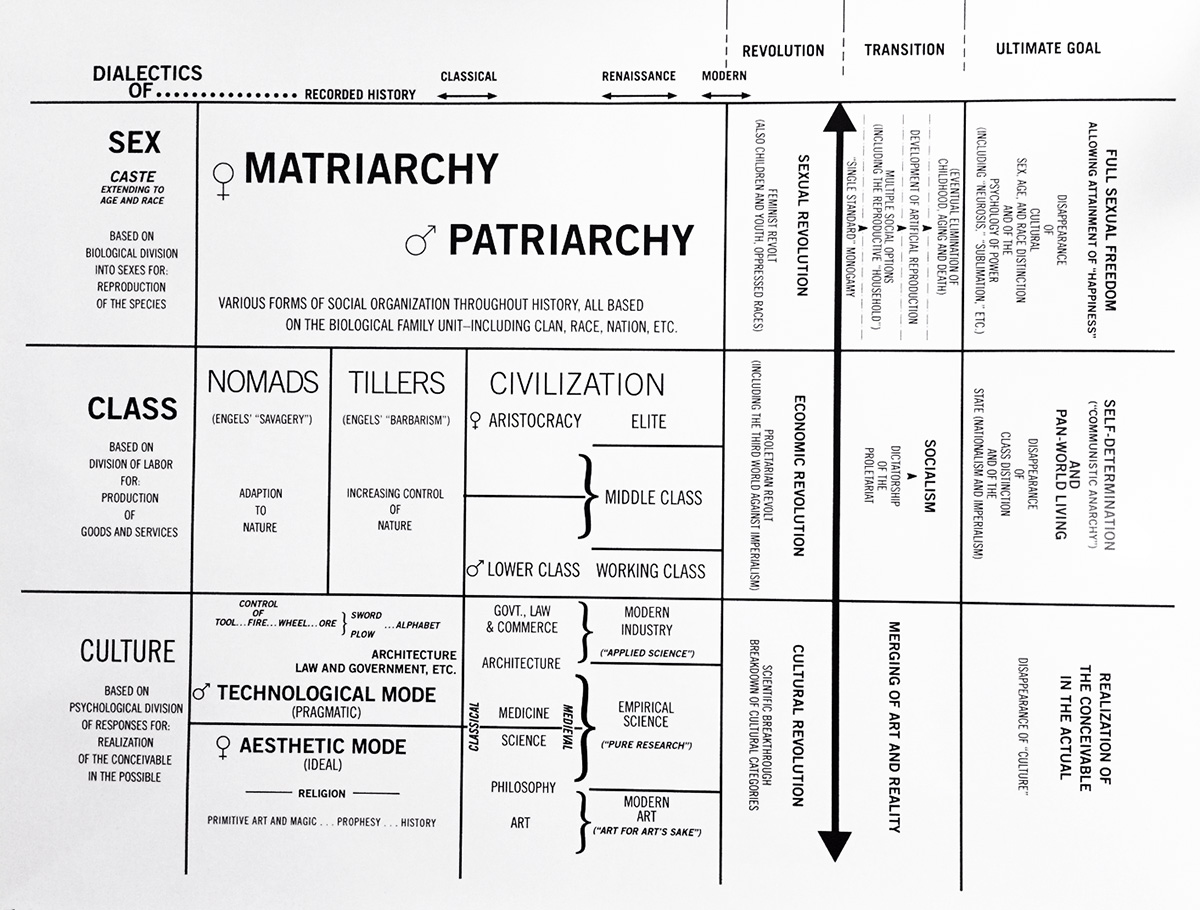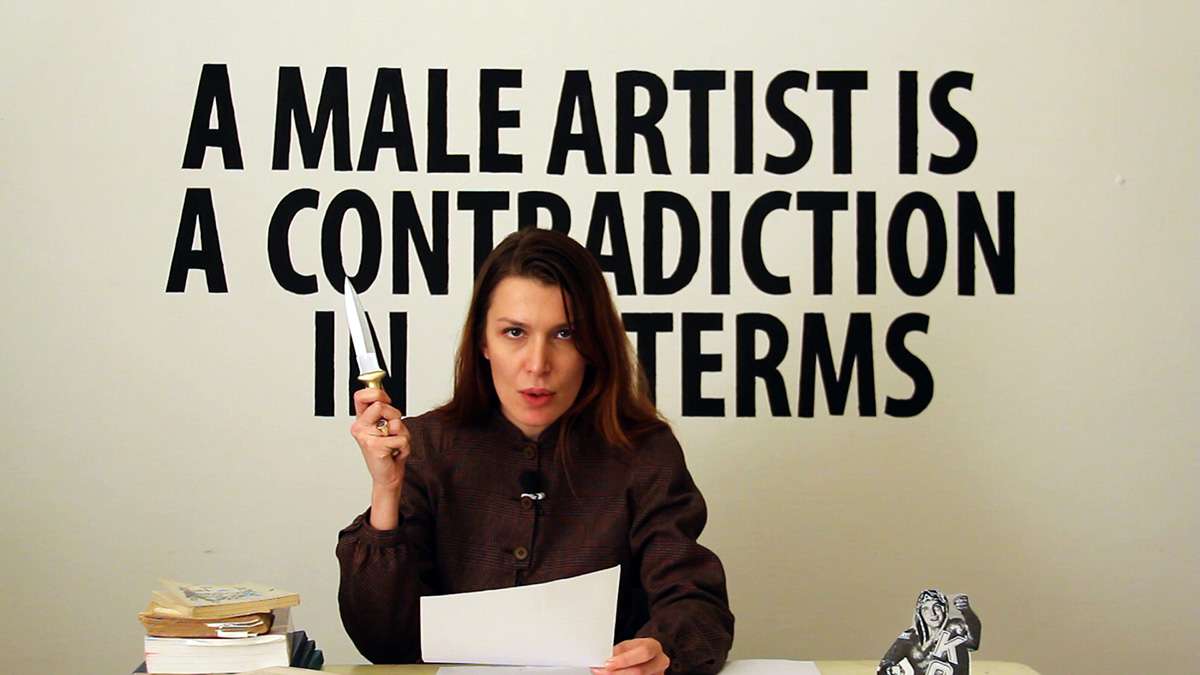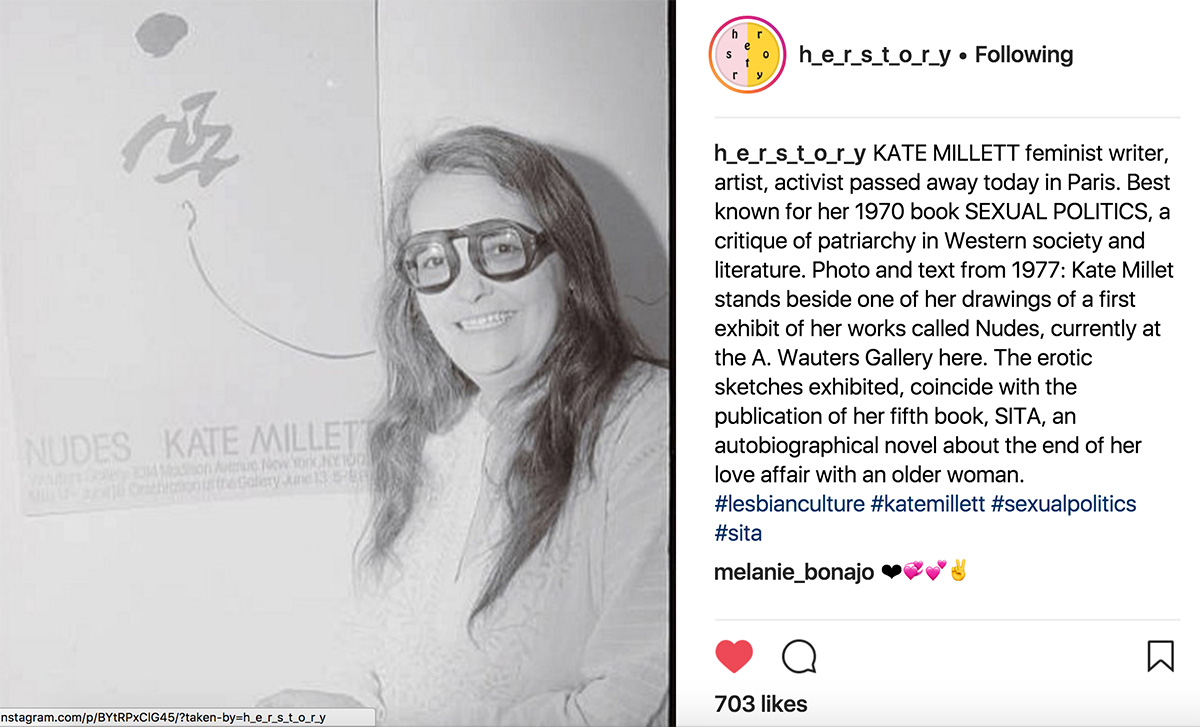Chiara Fumai and the Dead Feminist Society
Alison Gingeras
December 4, 2017

Kate Millett died in early September. I found out lying in bed, mindlessly scrolling through my phone. Instagram has supplanted the obituary page for me. Without the decorum and dignity of printed language, Deadstagram is both more instantaneous and annoying, sycophantic and heartfelt. These digital memento mori quickly kill death’s mysterious jouissance, especially when an iconic popstar dies suddenly, of an overdose or of unexpected natural causes. Prince, David Bowie, Carrie Fisher and her mom Debbie Reynolds, George Michael—the avalanche of fantributes, obscure candid pics, emoji-filled bereavement clog the flow and ostensibly extinguish our sense of loss with social media overexposure. I blame the millennials for ruining my own death ritual pleasures. But I digress.
Kate Millett didn’t have this problem. In fact, now that like-based algorithms have disrupted the direct chronological flow of Instagram, posts about Millett were buried in the stream. It took me a while to come across the news that she had passed. There were no viral hashtags, no #radfem, no runaway Sexual Politics memes. I only found three quiet posts on my Instagram feed, and a quick search shows only 500 honoring her loss. For comparison, there are currently 467,000 #ripprince posts. Kate’s memento mori took the form of covers of her iconic books (my tribute was an image of The Prostitution Papers) and the Alice Neel portrait of Kate on the cover of a 1970 issue of Time. RIP Kate.
I was supposed to call Kate this summer while in the throes of research for my forthcoming book, Sex Work: Feminist Art & Radical Politics. She uniquely straddled multiple spheres—radical theorist and practicing visual artist, lesbian liberationist and public intellectual who openly struggled with mental illness. In 1969, Betty Friedan advocated for an expulsion of lesbians from the National Organization of Women on the grounds that they would sideline mainstream feminism’s acceptance—spurring the infamous coinage lavender menace. Kate emerged as a Purple Monster who would push the limits of second-wave feminism. Now that she’s departed, I live in regret for procrastinating. I’m now haunted by Kate’s voice from a 2011 video clip that I’ve watched at least a dozen times. “I never get what I want… I’m a pioneer,” her voice suddenly raising. “Do you hear me? I’m a pioneer!”
Part of my passivity about Kate was my unconscious assumption that she would be forever accessible—an angry grande dame in the eternal cadre of radical feminists, those who could be plucked from the obscurity our amnesic age has imposed on most revolutionary intellectuals. Kate’s loss threw me down an internet rabbit hole, searching for the remaining living feminist thinkers who clashed with the consensual mainstream of ‘70s women’s liberation. Shulamith Firestone, Angela Carter, Susan Sontag: all of them dead. After attending Firestone’s 2013 funeral at St. Mark’s Church in the East Village (across the street from my house), a New Yorker journalist lamented that it felt like a burial for “a whole generation of feminists who had been unable to thrive in the world they had done so much to create.”

Depressed by this eulogizing, I pondered. Who even cares about dead radical feminists nowadays? The Italian artist Chiara Fumai surely did. Born in Rome in 1978, Fumai was known for a hybrid art practice that seamlessly conflated performance art, occult spiritualism, and Catholic ritual. Though little factual information about her biography is verifiable, her CV provides a skeleton of verifiable coordinates: formal schooling in Milan, Como and Arnheim; periods of residence in Bari, Rome and Brussels; and an exhibition history that spans some prestigious institutions such as documenta 13 (2012) and the Fondazione Querini Stampalia, in conjunction with Venice Biennale (2013).
Despite these data points, Fumai’s life remains shrouded in mythology. An article in Frieze begins by recounting that she was educated by Jesuits—reinforcing the Catholic mystique that perfumes her work and provides a credible indication of why she was preoccupied with the afterlife and spirituality—yet proclaims that she ultimately became a secular anarchist. This claim of radicality as the glue that unifies Fumai’s practice is rooted in an attempt to establish a personal canon of revolutionary women as the very raison d’etre for her art/life.
Taking the form of occult channeling rather than dramatic roleplay, Fumai’s performances revive a host of feminist figures from the margins of history—whether inhabiting the body of Marxist dissident Rosa Luxemburg, Carla Lonzi (the founder of the collective Rivolta Femminile, whose essays included “The Clitoral and the Vaginal Woman” and “Let’s Spit on Hegel”) or the ultimate Leftist outlaw—Red Army Faction militant Ulrike Meinhof.
In an age in which feminism has been fully corporatized, distilled into facile marketing hashtags, Fumai’s oeuvre is an earnest attempt to construct a dense, byzantine feminist history that weaves together a mishmash of lives based the artist’s subjective affinities and speculative fantasies. While her work takes the form of filmed performances or live performative lectures, Fumai positions herself as a time-traveling shaman, passing from the realms of the living and the dead to build a narrative based on the lives of other women from which she seemed to draw energy, inspiration, and agency.
Fumai goes beyond the reductive identity politics of #imwithher to become HER (and her and her and her). While not drawing from direct autobiographical experience, she constructed her own identity through an immersive, if magical-realist practice of resuscitating these historical figures. Fumai’s radical pantheon was an anti-monument, countering our current age’s short attention spans and middle-of-the-road understanding of feminism. There’s no leaning into Fumai’s revolution.
Take Fumai’s best-known performance, “Chiara Fumai Reads Valerie Solanas” (2012-13). The artist completely inhabited the cursed persona of the author of the SCUM Manifesto. A more accurate title for the piece would be “Valerie Solanas reading Valerie Solanas.” This was no mere appropriation; Fumai completely revived the dead anarchist. Sitting in front of a wall painting that read “Male Artist is a Contradiction in Terms,” Fumai stares down the camera and defiantly delivers passages from the manifesto with her spiteful Italian intonations sneaking into each syllable:

“Man is a walking dildo… Women do not have penis envy, men have pussy envy. When the male accepts his passivity, he defines himself as a woman and becomes a transvestite. He loses his desire to screw or do anything else for that matter. He fulfills himself drag queen [sic] and gets his dick chopped off.”
The wall paintings that accompanied her Society for Cutting Up Men revival looked like a three-dimensional incarnation of Shulamith Firestone’s epoch-making diagram that mapped the power structures of Matriarchy and Patriarchy in the opening pages of the Dialectics of Sex. Chiara made Solanas great again!
Solanas “was a speck and a spectre on the margins of extremist writing,” writes the philosopher Avital Ronell. “She adopted the language of a pest, plugging the kind of speech that counters while resembling hate speech.” Did Fumai really want to cut up men? No, yet Ronell’s description of Solanas’ revolutionary intent might apply to Fumai’s practice—her extremist incarnations of various luminaries from the Dead Feminist Society also operated like a mosquito. Its urgent buzzing and sporadic biting at the corpus of mainstream ideas worked to erode the standard catalogue of feminist references, to build a kind of temple to AltFeminism.
When I learned of Fumai’s suicide this summer, I sunk into an even deeper darkness. Given her marginal status in the art world, there was no Deadstagram for poor Chiara. While there were a handful of short obituaries online and in the Italian press, there was little insight into why she hung herself inside a commercial gallery in Bari (eerily named Galleria Doppelgänger). How could this artist who brought all the dead radicals back to life succumb to an early, self-inflicted demise? Who would carry the torch for all these women at the edges of feminism? No matter how I tried to repress the thought, I processed Fumai’s untimely death as a failure of her project.
Initially it was a struggle to get past my own cultural conditioning on this subject: suicide is a sin, a last resort, or as psychologist Roy Baumeister has theorized, “an escape from the self.” Was it inevitable that like the great Shulie Firestone—whose life ended as a schizophrenic believed to have starved herself—Fumai’s own radicality spared nothing, including herself?

Fumai’s struggles with depression and tragic end remind me of the morbid opening lines of Heroines, Kate Zambreno’s attempt to construct a feminist literary pantheon out of the “mad wives of modernism who died in the asylum. Locked, away, rendered safe. Forgotten, erased, or rewritten…Out of this narrative will emerge a chalk outline. It is the body of a woman.” How many of our heroines fall into the contours of this same outline—the psychobiographical ghetto of the “genial madwomen”?1
To escape these pathological confines, I hit the books. Suicide Century, Andrew Bennett’s recent exploration of literature as a privileged space “to consider suicide as a profound, unfathomable denial, destruction, or negation of the self, and simultaneously as an ultimate assertion of identity and agency” provides a kaleidoscopic compendium of quotes that redeemed Fumai’s death from clichés of madness, negation, and failure.
Maurice Blanchot offers, “He who kills himself is a great affirmer of the present because he still has the hope and strength to execute this extreme act, a hope and strength that is essentially and paradoxically life affirming ...suicide retains the power of an exceptional affirmation.”2
His fellow French Post-structuralist Michel Foucault—whose own suicide attempts informed his writing on the subject—took this affirmative recasting a step further, positing “suicide as a singular political act, as a ‘form of resistance’ to authority but one that, in destroying the agent of that resistance, paradoxically ‘serves power.’” In Michel Foucault’s terms, suicide operates “at the borders and in the interstices of power that [is] exercised over life.” I read these lines not to find comfort, but freedom from the confines of negation and ultimately to empower Fumai’s suicidal will—to understand how it could impact our conception of her oeuvre, the radical pantheon she constructed and the agency it might generate posthumously.
Thinking of Fumai in these terms, a line of Stevie Smith’s poetry comes to mind: “Death death death lovely death.” As Smith’s biographer Frances Spaulding noted, she “retained this deeply anarchic realization that death lay within her control.”3 A control that the anarchist Fumai—who channeled so many different lives—similarly exercised with great deliberation inside the Galleria Doppelgänger.
With these affirmations and assertions of will fueling my thoughts, I landed on the doorstep of The Church of Chiara Fumai, her online archive of video work. Catholicism is an inescapable cultural and conceptual frame of reference for anyone raised in the Church, even for those of us who ultimately become atheists. In my attempts to metabolize her death and reconcile it with her embrace of radical feminist history, I started to understand Fumai’s will to die as a necessary step in a process of her own, secular, canonization.
What is canonization if not a way to create a form of immortality through a mythologized death? The Vatican has a codified process of beatification in which admired figures become elevated into a public cult. The road to sainthood not only requires “proof” of the divine in the person’s life (in the form of miracles or being the recipient of heavenly apparitions) but sainthood is usually cinched by a tragic ending. Actual martyrdom or the badges of intense human suffering certainly help accelerate the process.
Extrapolating from Rome’s dogmas, it dawned on me how Fumai’s suicide could be recuperated as a form of martyrdom—her posthumous legacy undergoing a similar beatification process. She certainly satisfies the required proof of otherworldly apparitions in the course of her life’s work. In her performative work “The Book of Evil Spirits” (2015), Fumai “receives” the spirit of the infamous 19th-century occultist Eusapia Palladino much in the way the children who witnessed the Holy Virgin on a hillside in Fatima were deemed to have undergone “miracles worthy of belief.” Taking on Palladino’s spirit, Fumai performs for a séance that conjured forth a host of dead luminaries from her personal Dead Feminist Society. Clearly Fumai deeply believed in these transhistorical “possessions” as a means to rescue them from the margins of obscurity—but now that Fumai is gone, will she be granted a secular sainthood in order to be rescued from historical oblivion?
Suicide can be a powerful vehicle for achieving posthumous fame. The list of “greats” and “masters” who have risen phoenix-like from the shambles of an unsuccessful life, or from the ashes of despair is long: Vincent Van Gogh, Amedeo Modigliani, Emily Dickinson, Sylvia Plath, Zora Neale Hurston, Franz Kafka. But given Fumai’s entwinement of her life and work with the radical fringes of feminism, it would distort her legacy to construct a hagiographic account of a life so rooted in the veneration of the marginal. Fumai’s postmortem allegiances must remain within such a minor register.
“If I commit suicide,” Antonin Artaud said, “it will not be to destroy myself but to put myself back together again.” Our understanding of Fumai’s oeuvre (like Artaud’s) must be reassembled not within a paradigm of posthumous greatness and artistic mastery, but as heroine of the minor. Far from a disparaging term, Deleuze and Guattari’s theory of “minor literature” is centered on practices that evade codification by the dominant forces of society and its mainstream language, that can escape interpretation, that emphasize the political.
Like Kafka, upon whom Deleuze and Guattari elaborate their philosophy, Fumai made her work and constructed her identities from this minor position—an Italian woman in a misogynist society; an anarchist in a Catholic country; a feminist who espoused only the most extreme women thinkers, troublemakers, shamans, and activists; an artist who made ephemeral, occult performances in an art world that craves the commodifiable object. Fumai has certainly earned her place in the hallowed hall of the Dead Feminist Society—an irrepressible canon of radicals who belong to the cult of the minor, not the church of the mainstream.
- Jennifer Cizik Marshall “The Semiotics of Schizophrenia: Unica Zurn's Artistry and Illness” in Modern Language Studies, Vol. 30, No. 2 (Autumn, 2000), pp. 21-31Published by: Modern Language Studies Stable URL: http://www.jstor.org/stable/3195377).
- Maurice Blanchot, “The Space of Literature,” (Lincoln: University of Nebraska Press, 1982) page 103.
- Andrew Bennett, “Suicide Century: Literature and Suicide from James Joyce to David Foster Wallace (Cambridge: Cambridge University Press, 2017) p. 113